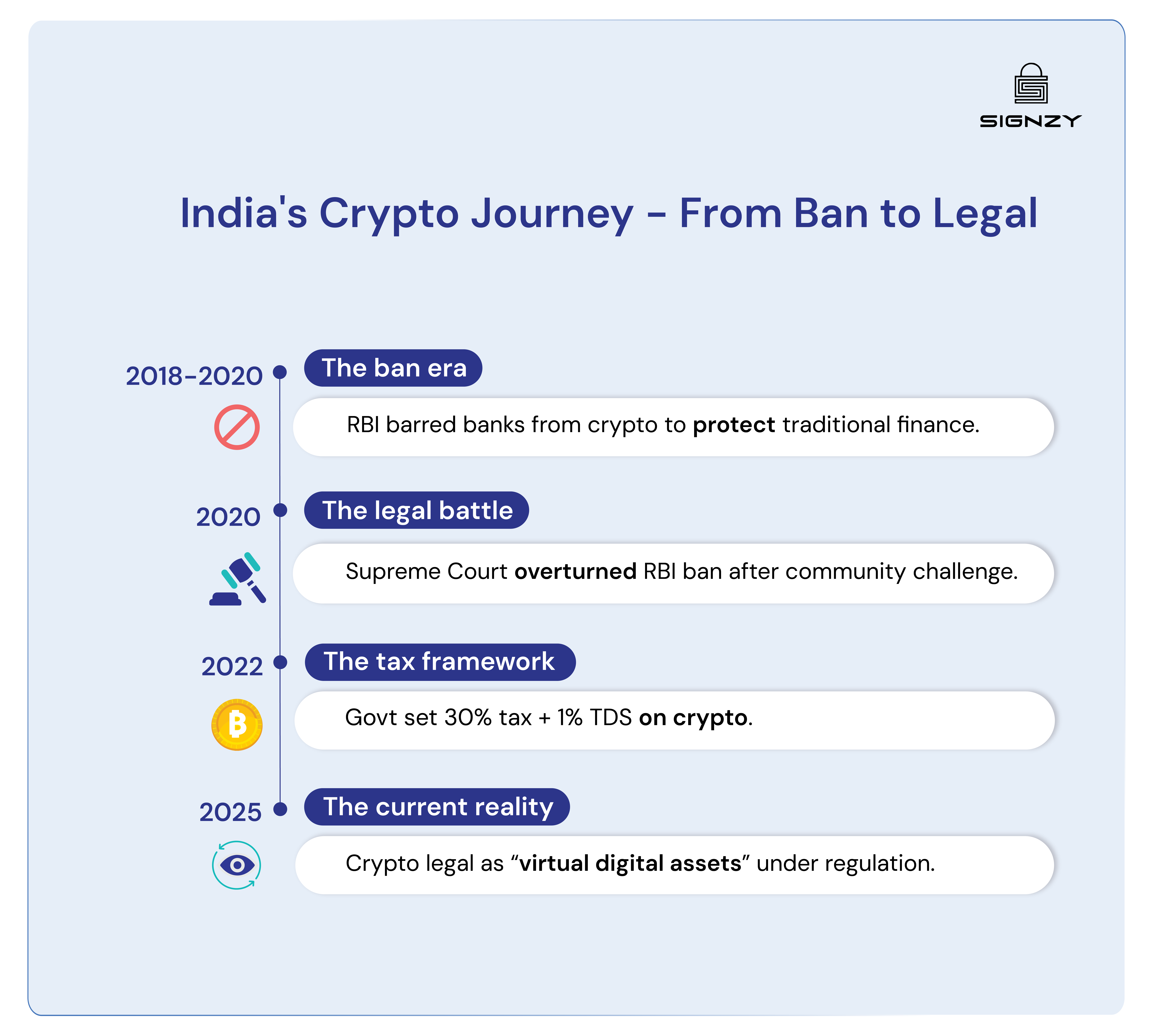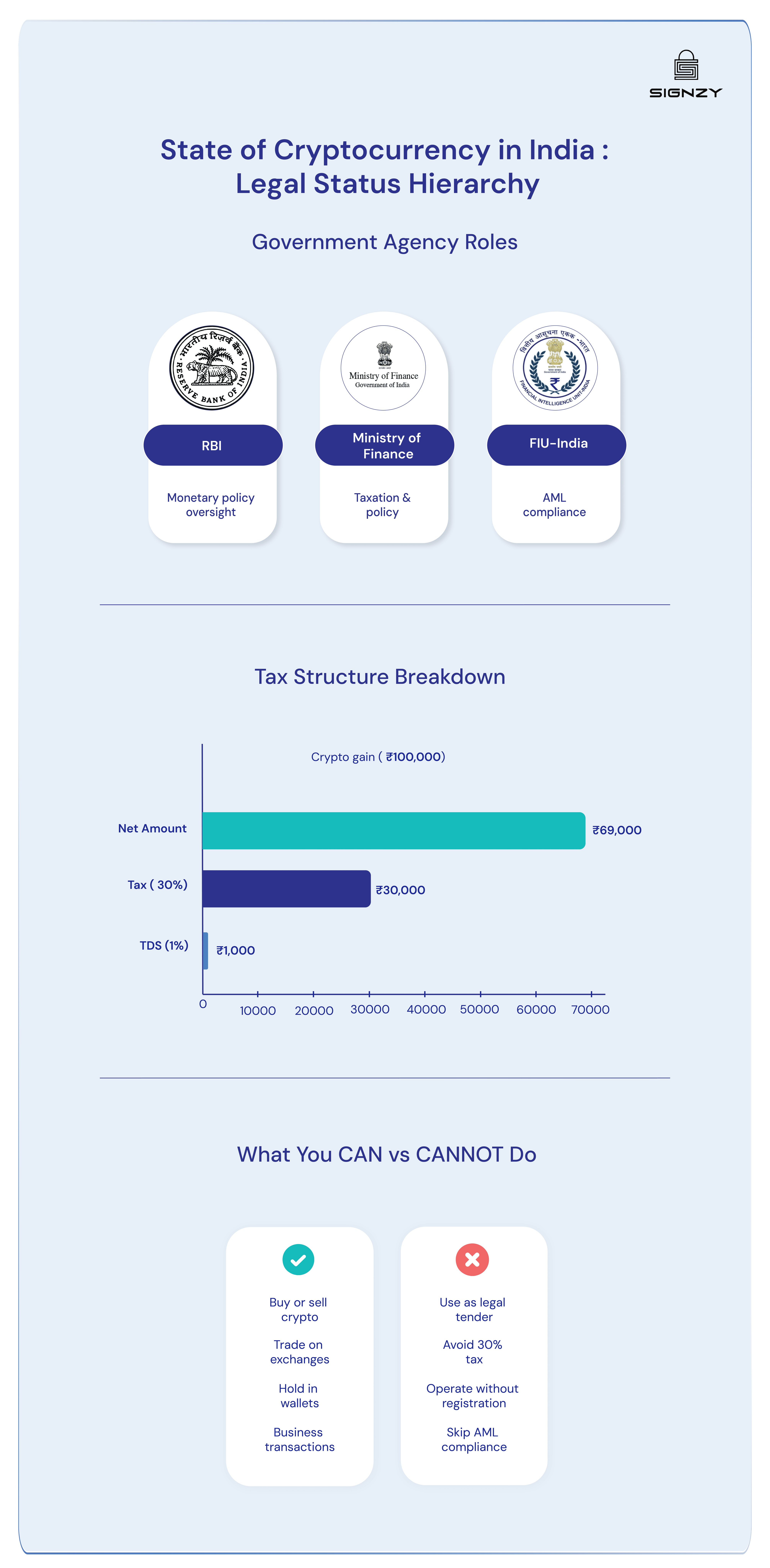Cryptocurrency in India: KYC and AML Regulations [2025 Guide]
- Crypto businesses in India now follow banking-level KYC and AML regulations since March 2023, when VDA service providers were brought under PMLA.
- FIU-IND registration is mandatory for all crypto platforms operating in India, including international exchanges serving Indian customers.
- India implemented the FATF Travel Rule with no minimum threshold, requiring detailed sender-receiver information for all crypto transfers.
If you’re dealing with crypto in India right now, you’re probably confused about what’s actually legal and what isn’t. One day, you’re reading about tax implications, the next day, there’s news about some exchange getting notices from authorities. It’s a mess, and frankly, most of us are just trying to figure out how to stay on the right side of the law.
The thing is, while the government hasn’t banned crypto outright (thank goodness), they’ve made it pretty clear that if you’re trading, investing, or running any kind of crypto business, you better have your KYC and AML compliance sorted.
So here’s what I’ve learned after digging through regulatory updates, talking to compliance experts, and yes, making a few mistakes along the way. This isn’t legal advice (obviously), but it’s a practical breakdown of what you actually need to know about crypto regulations in India as we head into 2025.
Related Solutions
What is the Legal Status of Cryptocurrencies in India?
In India, cryptocurrencies don’t technically exist as “cryptocurrencies” in legal terms. The government calls them Virtual Digital Assets or VDAs. And these VDAs (cryptocurrencies) are perfectly legal to own, buy, sell, and trade under the Income Tax Act, 1961. The Supreme Court even overturned an earlier banking ban in 2020.
Here are some other key highlights of India’s behaviour towards Cryptocurrencies.
- India employs a multi-agency approach to VDA oversight. The Reserve Bank of India maintains monetary policy oversight, the Ministry of Finance handles taxation and policy framework, and the Financial Intelligence Unit-India manages anti-money laundering compliance.
- VDA transactions are subject to a flat 30% tax rate on gains, with an additional 1% Tax Deducted at Source (TDS) on transfers above specified thresholds. This creates a distinct tax treatment compared to other capital assets.
- Since March 2023, all VDA service providers must register with FIU-IND under the Prevention of Money Laundering Act. This includes exchanges, wallet providers, and other intermediaries serving Indian users.
So basically, you can pay your business client with Bitcoin (only if they agree), but that won’t be considered as a legal tender. On top of that, you’ve to pay tax for this transaction.
💡 Related Blog:
What are the KYC and AML Regulations for Cryptocurrency Businesses in India?

If you’re running a crypto business in India, you’re basically dealing with banking-level regulations now. The government decided in March 2023 that crypto exchanges needed the same oversight as banks, which completely changed the game.
Below are some core KYC and AML regulations for cryptocurrency businesses in India.
1. RBI Know Your Customer (KYC) Directions
KYC is a primary step that involves knowing your customer with complete details. This is an unavoidable step for registered customers on your platform, a guideline levied by the RBI. It cannot be defined as just a clean practice because it’s beyond that. A compliance rule needs to be defined better.
Your customers must hand over the required documents to begin the processing. The process is thorough and all about verifying different IDs, their validity, to know who’s who. But the good news is, this can be automated through eKYC tools like Signzy.
2. Customer Due Diligence (CDD) and Enhanced Due Diligence (EDD)
Regular customer due diligence is what you’ll implement for every user now – basic information collection, document verification, and a risk assessment based on how they plan to use your platform. It’s become pretty standard across all registered exchanges.
Enhanced due diligence is where your compliance team’s work gets more intensive. When you’re dealing with politically connected individuals, large transaction volumes, or customers with connections to higher-risk countries, you’ll need to investigate much deeper.
Your team will need to verify the source of funds and implement enhanced monitoring for these accounts. It means more operational overhead and longer approval times, but it’s designed to catch problems before they become bigger regulatory issues for your business.
3. Prevention of Money Laundering Act (PMLA) 2002
The PMLA change in March 2023 fundamentally changed how cryptocurrency businesses need to structure operations in India. Your platform became a “reporting entity” with real legal obligations.
You have to register with the Financial Intelligence Unit, build comprehensive anti-money laundering programs, and face serious consequences if you don’t comply. We’re talking about heavy fines, frozen assets, and potentially getting your operations shut down entirely.
4. Suspicious Transaction Reporting (STR)
Say someone is suddenly moving ₹3 crore worth of crypto without any history. Or converting coins through mixing services. That’s suspicious. As a crypto business, you’re expected to flag and report this to FIU-IND.
You can find some common red flags below.
❗ Unusually large transactions compared to the customer’s profile
❗ Rapid movement of funds between multiple accounts
❗ Transactions involving high-risk jurisdictions
❗ Complex patterns designed to obscure fund sources
❗ Multiple small transactions just below reporting thresholds
The reporting system works on a “no questions asked” basis – platforms can’t inform customers that they’ve filed a suspicious transaction report.
5. FATF Travel Rule
This step is where things get global. India is part of the Financial Action Task Force (FATF), and it requires your platform to update them about the sender and receiver of a crypto transaction. Just like, while sending a parcel, you need to write the sender’s and receiver’s names. This is the same thing, but for a more serious topic: compliance. This maintains transparency across borders.
6. FIU-IND Registration as Reporting Entity
Every crypto service provider operating in India has to register with FIU-IND, including international platforms serving Indian customers.
The process takes several weeks to months for your business, and FIU-IND can reject applications if they’re not satisfied with your compliance setup. As of 2023, about 31 platforms had successfully completed registration, with major exchanges like WazirX, CoinDCX, and even international platform KuCoin making the cut.
7. Record Keeping and Transaction Monitoring
Verifying the KYC details once and forgetting about it? It isn’t appropriate business behaviour. You need to keep the records and monitor the transactions of your customers so that you can reverify whenever you see the need.
These systems need regular updates to stay ahead of new money laundering techniques, and platforms must be able to produce records quickly if regulators come asking.
8. Indian Cryptocurrency Bill
The Cryptocurrency and Regulation of Official Digital Currency Bill 2021 has been in limbo for years, but there are signs it might finally move forward in 2025.
The original draft proposed a complete ban on private crypto operations, but current expectations suggest comprehensive regulation instead of prohibition – good news for your platform’s long-term viability.
The bill’s evolution shows how much the government’s thinking has changed. It’s well understandable that crypto is now a part of India’s financial ecosystem, so is your cryptocurrency business. Just keep in mind the basics – build strong KYC and AML regulations, stay ahead in tech fields, and treat compliance as your stair to growth.
How Can Cryptocurrency Businesses Streamline KYC and AML Compliance?

Running compliance for a crypto exchange means dealing with tons of verification requests every day. Most platforms struggle with the paperwork, slow manual checks, and keeping up with all the regulatory requirements without hiring an army of compliance officers.
The answer is pretty straightforward – automate what you can. You’ve got two options here: build your own verification infrastructure from scratch, which means months of development, integrating with multiple data providers, and spending lakhs on compliance tech – or use a ready solution like Signzy that handles everything through one API.
With Signzy, you get document scanning, face verification, PAN checks, and adverse media screening built in. No need to piece together different services or worry about maintaining compliance infrastructure.
And if you are curious about how it works, book a free demo here.
FAQ
What is FIU-IND registration, and why is it mandatory?
How much tax do I pay on crypto profits in India?
What documents are needed for KYC on crypto exchanges?
Can international crypto exchanges operate in India?

Agrima Dwivedi
Agrima is an Associate Product Marketer at Signzy, currently working in the B2B fintech space. She brings over two years of experience in copywriting and content writing, which laid the foundation for product marketing. Today, she leverages both creative and strategic skills to drive go-to-market efforts and build user-focused marketing strategies.

![Cryptocurrency in India: KYC and AML Regulations [2025 Guide]](https://cdn.sanity.io/images/blrzl70g/production/18545a41d280d59abb7e03914da49843c1606b4e-2821x663.jpg)






